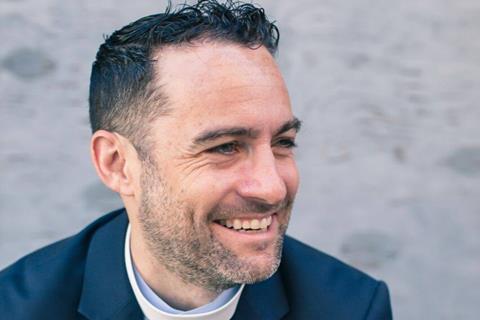When tragedy caused Aaron Damiani to doubt everything he believed, it was ancient church practices that provided him with the space and safety he needed to believe again

Strange as it sounds, it was Christianity that almost killed my Christian faith - not because it was so bad, but because it was so good. It excited me, challenged me, encouraged me and put me to work for the gospel - until I collapsed.
On my first day of Bible college, I ran up all 19 floors to reach my dorm room. As an 18-year-old, I was thrilled to expand my horizons. For years I had been a frustrated extrovert in a small American midwestern town, subsisting on a church youth group and Christian radio. Now that I was in the big city, among peers who shared my faith and level of desire to serve the Lord, I didn’t mind the 19 floors – or not at first.
Whatever the college program was, I was there for it: the new friends, daily chapel sessions, sermons from notable pastors, Christian concerts, theology classes, late-night conversations, evangelism and justice initiatives, baseball games and Chicago hot dogs, even the accountability partners.
A labour of love
For a while, everything worked. My teachers deepened my appreciation for the Bible and awakened me intellectually. My peers provided the iron-sharpening-iron spiritual community I was looking for. The worship nights stoked my passion for God. For someone who grew up in a Christian home and came to faith at the age of five, this was perhaps the closest I came to a conversion experience.
You might be surprised to know that Jesus led his disciples through a process of deconstruction
As the year drew to a close, I was encouraged to get involved in student leadership. There was a shortage of applicants for the leadership vacancies, I was told, and I was mature enough to step in to the gap. Later in life, I would learn that there usually is a shortage of leaders where they are most needed, and that need does not constitute a call. But at the time, I was deeply honoured to be asked and poured everything into the opportunity. I prayed for vision and made an elaborate, knock-’em-dead mural to communicate it. I spent time working with a cohort of new first year students, hoping to replicate in them the joyful experience I’d enjoyed the previous year.
Longing for lament
And then it happened. I’ll never forget the phone call from my close friend: “Aaron, my dad took his own life.” I didn’t know what to say. My friend’s family were committed Christians and had seemed so happy. I had not heard much about Christians committing suicide; the death was like an intruder in my otherwise happy existence.
At the time, my friends and I were attending a new, large church in the area. The worship was upbeat, the architecture was innovative (church in a warehouse? Cool at the time!), and our pastor had the “it” factor. The church was growing fast and we filled the huge parking lot with cars and the huge warehouse with people every Sunday, several times over.
Yet after the suicide, we didn’t so much need space to park the car as space to grieve the loss. We needed somewhere to be still before God, free of unnecessary noise and provocative personalities. We needed space from the happy and produced experiences so that our messy and human ones could run their course. We needed space not to have to feel anything at all, but simply to be welcomed into the presence of the Father, Son and Holy Spirit.
The wall
Meanwhile, my coursework changed to a minor key. As I learned how the Bible was written, collected, and held together, I grew disenchanted with it. I began to analyse God’s word from new angles, less interested in its power to refresh and convict. Even the tamest of exposures to postmodernism and critiques of the Christian faith, from believing, faithful lecturers, left me questioning all I had trusted. The more I learned, the less I believed. I felt like a bad Christian for entertaining these doubts and didn’t share my concerns with too many people. I was deconstructing, albeit reluctantly and privately.
That’s when the criticisms started from the ministry I was leading. And I didn’t have a healthy way to process the negative feedback. I could only feel the raw shame, fear and hurt. “He’s not investing in us enough”, “we don’t like his vision”, “he’s made some bad decisions”. The words stung. After all I’ve done to help and lead them! I fumed to myself.
I didn’t need the Church to deliver premium religious goods in exchange for my tithe; I needed Jesus
The world I had flourished in seemed to be turning against me. But instead of changing course, I doubled down into more of the same: more quiet times, worship music, sermons, ministry initiatives, theology - more learning, feeling, and trying. My friend David calls this the learn-more-do-more treadmill. Struggling in your faith? Learn more. In a relational crisis? Do more. It’s worked before; it should work again. It was like attempting those 19 flights of stairs, only this time I collapsed before reaching the top.
With my emotions fried, my thoughts confused and my energy for Christian service depleted, I hit a wall. I couldn’t feel my way to God anymore - not in my old way of doing that, at least. I couldn’t think and learn my way to God and I couldn’t serve and lead my way to God. Yet I longed for his presence.
Need to breathe
Around that time, my friend Phil invited me to his church. Covenant Presbyterian met in an old converted Polish Catholic church building. It was austere - no statues of saints remained - with cracked walls and stiff pews. Yet the architecture was beautiful and sturdy, and it lifted my gaze heavenward.
Within these old stone walls, I was given old prayers to pray. I learned that the Church could be like a mother, who instinctively knows what her child needs as they walk through the door: “Come on in; here’s a chair for your tired body. You must be famished; here’s some food. I’ve got your bed ready, but first, a hug. Bring it in.”
I arrived at Covenant weary and heavy-laden. She welcomed me like a son: “Here, try these prayers. You don’t have to come up with new ones. They are all just scripture, stitched together. You don’t have to feel them or even believe them, just take your seat and pray with the family.” In my state of burnout, I could receive a set of prayers as beautiful and ancient as the architecture. As I prayed, the text lifted my soul heavenward, too.
I had always heard that liturgy and formalities in church were works-salvation: an empty set of rituals. Yet for me, the historic forms and seasons of the Church put the grace of Jesus on full display and gave me a way to participate. It was like the “easy yoke” that Jesus spoke of. It fitted, light and easy, and the longer I wore it, the more I learned of his gentle and lowly heart. My soul started to rest.
Starting over
It might sound as if I’m describing an impossibly perfect church, but it wasn’t. More importantly, it didn’t need to be; perfect was what had exhausted me in the first place. I didn’t need the Church to deliver premium religious goods and services in exchange for my tithe dollars, I needed Jesus, in all his simplicity and beauty. The liturgical, historic forms of worship led me to him.
The sermon did not have to be the main event that drew people back each week. The preaching could simply be a verbalised gospel, with the sacraments of communion and baptism working in tandem; a visualised gospel for all to see. The Church could be that mother, standing on the porch with open arms, crying out like Lady Wisdom: “Come and see the gospel! Come and taste the gospel! Come and pray the gospel! Come buy wine and milk without money and without price!”
Looking back, I was still a mess, with plenty of issues. Liturgy is not a panacea for the human condition, but it is a start. I was like a sapling, bent over and misshapen, but lashed next to a giant, healthy tree and being husbanded by the Holy Spirit. My roots would deepen slowly; the fruit would eventually appear. And my head and my heart would, in time, catch up with my body. But first, I needed to rest, receive, and slow down. Liturgy, an essential part of the sacramental life, helped me do that.
As I’ve talked to other Christians, I’ve realised that even the most zealous believers hit challenges, seasons of doubt or dryness that leave them aching for more. The easy yoke of the ancient Church can strengthen our faith after the world, the flesh and the devil have done their best to snuff it out. The creeds and calendar, the passing of the peace and the praying of old prayers can work together to create a pattern of worship that renews our hearts and sustains our calling.
The historic forms put the grace of Jesus on full display and gave me a way to participate
Yet for so many, their church-related pain and suspicion leads them to deconstruct their faith instead of deepening it. I get it - I was almost there myself. The deconstruction process involves questioning what leaders have taught us and discarding old beliefs, structures and people that used to form the fabric of our faith. Eventually, we move on to something more authentic, healthy and pure - at least in theory.
Healthy deconstruction
You might be surprised to know that Jesus led his disciples through a process of deconstruction. They came into his circle with all kinds of expectations. They hoped for a triumphant king when, in fact, Jesus was destined to be a crucified one. Like us, the disciples wanted power and control, not persecution and suffering. Jesus deconstructed this with patient correction and, finally, by his own death on the cross. Whether cleansing the temple (Mark 11:15–19) or correcting false assumptions (Luke 24:13–49), Jesus stands ready to deconstruct idols, unjust structures, non-biblical expectations and anything unholy or untrue. It’s a healthy, normal part of our faith maturation.
Yet the one thing that Jesus does not deconstruct is his bride, the Church. Sure, he may correct, reform and purify her (Ephesians 5:25–27; Revelation 2-3). But he does not abandon, divorce or dismantle her. In fact, Jesus builds, fills and empowers his Church for her mission. “I will build my church, and the gates of hell will not stand against it” (Matthew 16:18). Even more, Paul tells us that the Father gave his Son to the Church, “which is his very body, the fullness of him who fills all in all” (Ephesian 1:23). As my friend Scott says, if you want to see Jesus in this life, you cannot look over the shoulder of his local church.
And why would we? She is Christ’s beautiful bride, made up of our brothers and sisters around the world and throughout time. And she stands ready, like a mother, to welcome all her weary and heavy-laden children home.



































No comments yet